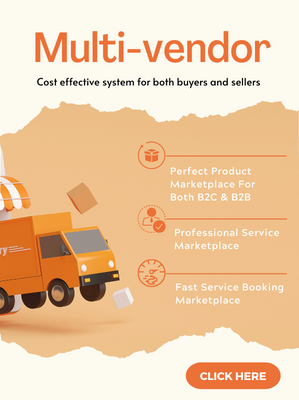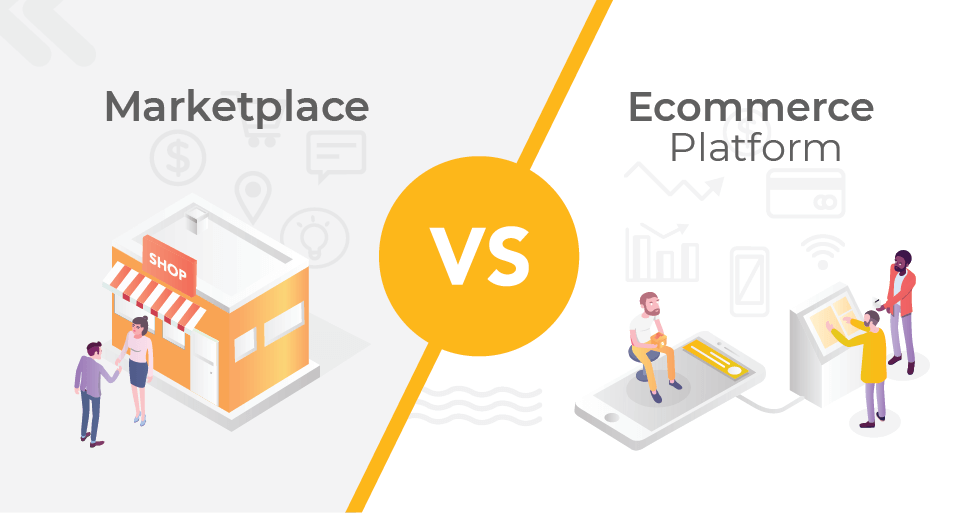When Covid-19 has happened, Digital Transformation developed and affected our life considerably. You can see a range of new trends and technologies appearing and growing such as 5G, AR/VR, Headless and API-driven eCommerce,…Therefore, thanks to Digital transformation, other platforms can take advantage of it, and eCommerce isn’t an exception. This is the reason we write this post to tell you about how to apply digital transformation in eCommerce businesses effectively
Digital transformation definition

An essential adjustment in how business functions, communicates and interacts with customers is the digital transformation. The shift toward more digital operations is an interruption of the “conventional” manner of doing things. It’s also important to foster a digital culture within your organization and upskill your workforce because transformations require a team effort.
Types of digital transformation in eCommerce
Although many businesses concentrate on organizational change, there are four different forms of digital transformation in eCommerce to take into account if you want to get the most out of it. These consist of:
Process Transformation: This concentrates on your processes, including data, analytics, AI, and any other procedures that can help your company save money and run more efficiently. The world’s largest healthcare retailer Walgreens is a great illustration of this, having just updated its MyWalgreens app to better serve its customers and concentrate its digital assets.
Business model transformation: It is the process of making fundamental adjustments to the way a company or organization operates. These adjustments can be made to people, procedures, and technology. Consider Netflix, a company with enormous influence, and how it utterly upended the video distribution industry’s business model.
Domain Transformation: By obtaining new technology, this area presents a fantastic opportunity for a corporation to enter a new domain or sector that it may not have previously investigated. Consider Google and all of its commercial ventures, like Google Nest, an Internet of Things (IoT) device that offers smoke alarms and thermostats for the house.
Cultural/Organizational Transformation: This entails changing mindsets, procedures, capacities, and talents in light of the digital age. It entails advancing digital transformation through expansion projects that are founded on a fresh culture and style of thinking. Pitney Bowes is a fantastic illustration of this because it changed from providing mailing solutions to providing shipping and eCommerce technology before becoming a digital corporation.
Benefits of digital transformation in eCommerce
For a business and its workers, digital transformation has a number of advantages, including:
- Changes how UI/UX
- Facilitates data-based insights
- Promotes collaboration and enhances employee satisfaction
- Increases creativity and agility
- Updates knowledge and abilities
- Encourages the digital culture
- Combines processes and operations
Forces Driving the Increased Focus on Digital Transformation in eCommerce

1. Online shoppers are shopping for goods.
What do you always do first when you want to buy something? The majority of the time, you’ll search online while looking for reviews, pricing options, and other information. Having said that, it is imperative to make your business’s goods or services easily accessible to web browsers who may become consumers.
Due to the intense rivalry in the internet market, brands are using every strategy at their disposal to stay one step ahead of their rivals. Businesses need to offer their customers a compelling purchasing experience more than ever, especially given the popularity of Internet shopping.
Do you offer customers an easy way to view your products online? Do you have a website that is properly optimized to make sure that customers can find you right away?
2. The necessary for a strong online presence to demonstrate the value
A strong internet presence gives firms direct access to customers, eliminating the need for middlemen. eCommerce development is an excellent technique to enhance your brand’s reputation because it gives customers the opportunity to communicate directly with your company.
3. Goods are becoming digitalized
Consumers today demand a specific kind of experience, which is relevant to the prior point. Because there are so many possibilities, they will explore around until they discover what they need. Businesses are using digital transformation to enter the eCommerce space as one method of making goods easily accessible to customers. An organization can now access new markets and opportunities when it digitizes its products. When you offer things directly on your own digital marketplace or through third-party websites like Amazon, selling products becomes simple.
4. Customer expectations are still increasing.
Modern consumers are picky, and they value tailored interactions across all media. People now frequently use various equipment to approach the internet, therefore they value smooth processes.
5. Product optimization is taking place.
By gathering, analyzing, and sharing real-time data, digital transformation is enabling businesses to employ technology to unleash value within their organization. Businesses are changing their operations in light of this data (e.g., reworking fulfillment processes and logistics and adjusting their pricing structures).
How will digital transformation impact the future of eCommerce?

1. Private-label and direct-to-consumer (DTC) sales are increasing.
Prior to recently, the majority of brands—especially new brands—established alliances with significant physical stores. The fact that brand makers engaged in wholesale transactions cost them huge earnings. While this was going on, their retail partners created more and more private-label variations of branded goods.
DTC’s business plan reflects both a goal to increase profits and a response to the popularity of private label goods. Brands that use a direct-to-consumer strategy gain more than just extra money; they also gain a deeper understanding of their target market. Manufacturers counterbalance slow in-store sales by picking DTC eCommerce over their retail partners.
Let’s examine some of the DTC strategy’s further advantages in more detail.
The consumer bases of brands are better understood.
Brand owners lose direct contact with customers when they enter into wholesale agreements with merchants. From that point forward, they depend on customer reviews, voluntary consumer feedback, and post-sale surveys to understand the end users of their products.
Businesses are able to recapture that consumer connection when they adopt a DTC strategy. Customers connect with brand makers directly, and they receive prompt and efficient help in return. Businesses that implement DTC also recover the capacity to collect consumer information in order to better understand their customers.
A distinctive consumer experience is offered by DTC.
More than 55% of consumers, via a survey by iXtenso magazine, prefer to deal directly with brand makers. Custom packaging, mix-and-match product assortments, and seasonal exclusives are all on their must-have list because they want a personalized experience.
More revenues are generated by brand makers who embrace omnichannel marketing to provide a smooth user experience across devices. Companies who use DTC have complete control over their customers’ experiences, giving them a great deal of leverage to raise customer happiness.
Develop customer relationships based on your brand.
When businesses sell goods directly to customers, they create a new generation of brand ambassadors who spread the word about their favorite goods. Buyers that are devoted to a brand have a tendency to continue with it for a long time and develop it into valuable assets, enhancing your customer retention rate.
In the long run, businesses that build strong relationships with their customers always succeed. Additionally, you don’t have to wait to develop a relationship with a brand. Manufacturer of water bottles Larq started its DTC approach far in advance of the company’s launch, which led to an incredibly successful initial crowdfunding campaign and a committed customer base.
2. Augmented reality eliminates the restrictions associated with online shopping.
Because it enables customers to visualize the things that interest them, augmented reality (AR) software is a game-changer in the eCommerce sector. Consumers relied on their imaginations, tape measurements, and chance before AR. They couldn’t confidently see products in their minds. By eliminating this significant psychological barrier to buying, AR integrations transformed eCommerce.
eCommerce SaaS platforms like BigCommerce provide a variety of augmented reality integrations. LIVEb4buy, for instance, enables eCommerce merchants to design 360-degree panoramic venues (the inside of physical stores, demo spaces with furniture in them, and so on). In order to understand more about the things they choose, customers “walk” through these areas.
3. eCommerce is increasingly replacing physical retail as the main revenue source for many companies.
During the COVID-19 pandemic, brick-and-mortar shops and wholesalers suffered greatly when they had to close their doors. Ecommerce shops found themselves residing in Boomtown, but behind the scenes, time-honored packaging and shipping procedures fell apart as a result of a drop in warehouse workers due to social estrangement. Due to the overwhelming volume of packages, shipping times significantly increased.
Eventually, panic shopping subsided, leaving shopkeepers to sort through the debris. Businesses without websites quickly launched online storefronts and those that already had one updated their operations and storage options to be ready for any potential chaos. Newly closed businesses in towns all around the nation announce the sudden demise of High Street dominance.
Before the pandemic, eCommerce had already been predicted to succeed. Economic forecasters now predict that retail eCommerce sales will reach 476.5 billion dollars by 2024, up from 279.7 billion dollars in 2017. Digital transformation is no longer just a buzzword; it is now a necessary procedure for traditional brick-and-mortar organizations.
4. Big data will be crucial in improving customization.

Huge data is big business and a key component of the transition to a digital business model. Big data is used by major online retailers like Amazon to offer users highly customized shopping experiences. How do they perform this magic? by adapting site algorithms based on historical user behavior using machine learning. Like your neighborhood barber, online behemoths understand that familiarity increases profits.
People may find it simpler to reject personalization in the future. Companies are still pushing for personalization in the Internet of Things (IoT) devices like thermostats, doorbells, and AI technology for the time being (think Amazon Alexa or Siri). You can add product suggestion connections to your website if you want to include big data and personalization into your new business strategy.
5. eCommerce powered by APIs and without a head enables ongoing innovation.
Most individuals are unaware of how their preferred websites operate. During lunch, they go on to the internet, visit Larq, order a Midnight Rendezvous gift set, and then return to work. Their order preferences are transmitted through Larq’s headless commerce system invisibly and faster than the speed of sound, where they are neatly stored in the database.
The sole option for eCommerce is headless, as recognized by businesses like Larq. Shortly, headless eCommerce separates a company’s front end from its eCommerce platform. Application programming interfaces (APIs) allow any data entered into Larq’s backend to flow effortlessly to a variety of frontends, such as progressive web applications (PWAs) and content management systems (CMSs).
Companies that employ headless commerce add content to a backend that is compatible and depend on APIs, such as a customized frontend (Larq used React) and a mobile app. Don’t worry if that sounds complicated. Headless commerce is made simple by a number of eCommerce platforms, including SaaS choices like BigCommerce.
Additional justifications for headless commerce include the following:
Flexibility: Headless commerce is adaptable and agile across a variety of devices, and it is SEO friendly. Additionally, it simplifies multi-region platforming and makes companies develop a single domain for cross-border trade.
Personalization and customization: Customers want to have the ability to stop shopping on one device and pick it up again on another, often much later. Using a headless commerce tech stack, which streams data from a single central database to a number of APIs, businesses can manage the whole customer experience.
6. Acceptance of alternative payment systems on a large scale.
Credit cards have dominated consumer purchasing for a century since they were first created, which is astonishing considering they were founded in the 1920s. Alternative payment mechanisms, such as blockchain-based systems like Bitcoin, are the newest players in the market. However, buy-now-pay-later (BNPL) services, which have a sizable following among the millennial generation, are particularly well-liked.
Modern eCommerce businesses must provide their customers with a variety of payment alternatives, including BNPL choices, in order to stay competitive. Given that their items usually fall into the category of want-but-not-need, luxury goods and apparel companies should pay special attention to this aspect of digital transformation. No room in the ordinary consumer’s monthly budget for a designer dress? You might attract a new fan by offering a monthly payment option without interest.
7. Mobile buying is still growing.
By 2021, approximately 73% of eCommerce transactions, according to Statista’s most recent data, are expected to be completed on mobile devices. Customers almost always have a choice of wholesaler or retailer; if you don’t give them a seamless shopping experience, they’ll just go somewhere else. Do not overlook this element of a digital revolution.
8. The emphasis for businesses will be on optimization.
In fact, many professionals view conversion rate optimization, or CRO, as an imperative follow-on to effective SEO. CRO strategies turn users into buyers while SEO tactics bring traffic to your website. Businesses can increase the profitability of their existing Google and Bing leads by using efficient CRO frameworks.
CRO approaches optimization iteratively. Administrators make changes to the website and track outcomes to determine their effectiveness. Every update has a purpose and is made with the goal of enhancing the user experience. Simpler checkout procedures, better navigation choices, and attractive product descriptions all minimize friction and increase the likelihood of purchases.
eCommerce retailers virtually always notice an improvement in earnings when they utilize CRO to improve their websites. Many proactive CIOs (chief information officers) invest those revenues directly back into SEO, resulting in increased traffic and conversion rates.
>>> Read more : Digital transformation trends: Top 10 key trends for 2022
Guidelines for Creating a Successful Digital Transformation Strategy
You need to have a sound strategy in place if you want to use digital transformation to put your company ahead of the competition. When creating a framework for digital transformation, consider the following steps:

1. Identify your digital transformation goals.
Identifying your ultimate goals should always come before making any company decisions. What do you hope to accomplish by integrating digital transformation in eCommerce business practices? Whatever your particular objectives, they should be closely related to your profit objectives and intended business results.
When developing your strategy for digital transformation, keep the following objectives in mind:
- Boost productivity and enhance user experience
- Increase repeat business
- Cut back on operating expenses
- Make business processes less complicated
- Increase efficiency and develop knowledge of digital assets
2. Analyze the situation and evaluate performance.
Reviewing the potential areas for improvement, such as implementing digital marketing technology, would be the following step. Additionally, it would be wise to recognize and assess any potential constraints.
Various industries have different standards, but as a general guideline, here are some ways to evaluate your situation:
- SWOT Analysis: What are your advantages, disadvantages, opportunities, and threats?
- Customer research: What kind of internet audience engages with you? What characteristics do they have? How will people react to the different mediums you employ?
- Competitive Analysis: It would be wise to research your competitors before implementing any company strategies. In what ways do they compete in the 5Ds of digital?
- Analyzing the performance of each marketing channel, what effect will each have on your company’s operations?
3. Acquire a thorough knowledge of the technical specifications.
You must be aware of where your company is in terms of technological prowess and IT expertise. Do you possess the organizational framework required to implement the ideal customer experience? Analyze your present platforms as well. To keep yourself from being constrained by technology, you might need to abandon or platform some systems.
4. Think about augmented reality
Doubt and ongoing fraud instances are the biggest issues with online shopping. A customer might have seen a product online that they want to buy, but they don’t know if it’s an accurate portrayal of what they’re looking for.
Online retailers frequently face accusations that the things they supplied were different from what they had online. Augmented reality (AR) can be useful in this situation. You may assist customers in visualizing the products before buying with AR software apps. By eliminating some of the main psychological barriers to purchase, AR integrations transform e-commerce.
5. Think about other payment options.
In order to serve all clients, it’s crucial to offer different payment options. Credit card payments, bank transfers, virtual mobile wallets like PayPal, and cryptocurrencies like Bitcoin are examples of this, although they are not the only ones.
Conclusion
We come to the end of the post. Digital transformation is a part and parcel of our lives and has a direct impact on lots of fields. It brings new technologies which make everything become convenient and smooth. Therefore, you should apply digital transformation in eCommerce store. And we hope with our post, you can have some helpful information. If you have any questions, just contact us.
Top best B2B eCommerce platform to scale your B2B business rapidly



